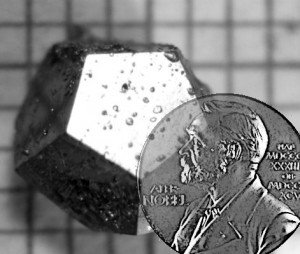Israeli physicist Daniel Shechtman was last night awarded the Nobel Prize for chemistry for his discovery of “quasicrystals” in metals – crystals with strange structures scientists had thought to be impossible.
 The UK SMC rounded up reaction from scientists:
The UK SMC rounded up reaction from scientists:
Dr Andrew Goodwin, Department of Chemistry at Oxford University, comments:
“Daniel Shechtman’s award of the 2011 Nobel Prize in Chemistry is fantastic recognition of the continued impact of fundamental research into the structure of materials.
“For the last century, our understanding of the arrangement of atoms in materials – from DNA to superconductors – has been built on the rules of crystallography: rules which assume atoms are arranged like tiles in a regular, repeating arrangement.
“When studying a series of alloyed metals, Professor Shechtman showed how nature can and does break these rules by including pentagon-like symmetries which prevent the atomic ’tiles’ from ever repeating. Instead the atoms in these alloys follow the same remarkable ‘quasi-periodic’ patterns discovered centuries ago by Islamic artists.
“Schechtman’s quasi-crystals are now widely used to improve the mechanical properties of engineering materials and are the basis of an entirely new branch of structural science. If there is one particular lesson we are taking from his research it is not to underestimate the imagination of nature herself.”
Professor David Phillips, President of the Royal Society of Chemistry, said:
“Quasicrystals are a fascinating aspect of chemical and material science – crystals that break all the rules of being a crystal at all!
“You can normally explain in simple terms where in a crystal each atom sits – they are very symmetrical. With quasicrystals, that symmetry is broken: there are regular patterns in the structure, but never repeating.
“They’re quite beautiful, and have potential applications in protective alloys and coatings. The award of the Nobel Prize to Dany Shechtman is a celebration of fundamental research.”